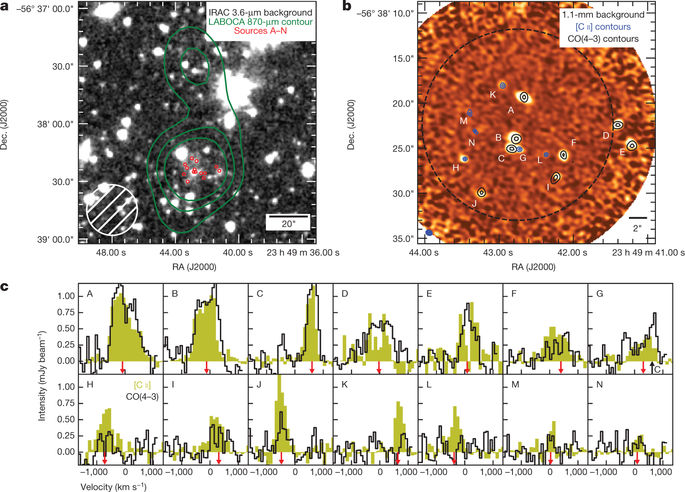Our official English website, www.x-mol.net, welcomes your
feedback! (Note: you will need to create a separate account there.)
A massive core for a cluster of galaxies at a redshift of 4.3
Nature ( IF 50.5 ) Pub Date : 2018-04-01 , DOI: 10.1038/s41586-018-0025-2 T. B. Miller , S. C. Chapman , M. Aravena , M. L. N. Ashby , C. C. Hayward , J. D. Vieira , A. Weiß , A. Babul , M. Béthermin , C. M. Bradford , M. Brodwin , J. E. Carlstrom , Chian-Chou Chen , D. J. M. Cunningham , C. De Breuck , A. H. Gonzalez , T. R. Greve , J. Harnett , Y. Hezaveh , K. Lacaille , K. C. Litke , J. Ma , M. Malkan , D. P. Marrone , W. Morningstar , E. J. Murphy , D. Narayanan , E. Pass , R. Perry , K. A. Phadke , D. Rennehan , K. M. Rotermund , J. Simpson , J. S. Spilker , J. Sreevani , A. A. Stark , M. L. Strandet , A. L. Strom
Nature ( IF 50.5 ) Pub Date : 2018-04-01 , DOI: 10.1038/s41586-018-0025-2 T. B. Miller , S. C. Chapman , M. Aravena , M. L. N. Ashby , C. C. Hayward , J. D. Vieira , A. Weiß , A. Babul , M. Béthermin , C. M. Bradford , M. Brodwin , J. E. Carlstrom , Chian-Chou Chen , D. J. M. Cunningham , C. De Breuck , A. H. Gonzalez , T. R. Greve , J. Harnett , Y. Hezaveh , K. Lacaille , K. C. Litke , J. Ma , M. Malkan , D. P. Marrone , W. Morningstar , E. J. Murphy , D. Narayanan , E. Pass , R. Perry , K. A. Phadke , D. Rennehan , K. M. Rotermund , J. Simpson , J. S. Spilker , J. Sreevani , A. A. Stark , M. L. Strandet , A. L. Strom

|
Massive galaxy clusters have been found that date to times as early as three billion years after the Big Bang, containing stars that formed at even earlier epochs1–3. The high-redshift progenitors of these galaxy clusters—termed ‘protoclusters’—can be identified in cosmological simulations that have the highest overdensities (greater-than-average densities) of dark matter4–6. Protoclusters are expected to contain extremely massive galaxies that can be observed as luminous starbursts7. However, recent detections of possible protoclusters hosting such starbursts8–11 do not support the kind of rapid cluster-core formation expected from simulations12: the structures observed contain only a handful of starbursting galaxies spread throughout a broad region, with poor evidence for eventual collapse into a protocluster. Here we report observations of carbon monoxide and ionized carbon emission from the source SPT2349-56. We find that this source consists of at least 14 gas-rich galaxies, all lying at redshifts of 4.31. We demonstrate that each of these galaxies is forming stars between 50 and 1,000 times more quickly than our own Milky Way, and that all are located within a projected region that is only around 130 kiloparsecs in diameter. This galaxy surface density is more than ten times the average blank-field value (integrated over all redshifts), and more than 1,000 times the average field volume density. The velocity dispersion (approximately 410 kilometres per second) of these galaxies and the enormous gas and star-formation densities suggest that this system represents the core of a cluster of galaxies that was already at an advanced stage of formation when the Universe was only 1.4 billion years old. A comparison with other known protoclusters at high redshifts shows that SPT2349-56 could be building one of the most massive structures in the Universe today.Observations of carbon monoxide and ionized carbon lines from the source SPT2349-56 show it to contain a cluster of at least fourteen gas-rich galaxies with redshifts of 4.31, in a highly dense core region.
中文翻译:

红移为 4.3 的星系团的巨大核心
早在大爆炸后 30 亿年,就已经发现了巨大的星系团,其中包含形成于更早时期 1-3 的恒星。这些星系团的高红移前身——被称为“原星系团”——可以在宇宙学模拟中被识别出来,它们具有最高的暗物质过密度(大于平均密度)4-6。预计原星团将包含可以作为发光星暴观察到的超大质量星系。然而,最近对可能包含此类星爆 8-11 的原始星团的探测并不支持模拟中预期的那种快速星团核心形成 12:观察到的结构仅包含少数分布在广阔区域的星爆星系,没有证据表明最终会坍缩成一个原集群。在这里,我们报告了来自 SPT2349-56 源的一氧化碳和电离碳排放的观察结果。我们发现这个来源至少由 14 个富含气体的星系组成,所有星系都位于 4.31 的红移处。我们证明,这些星系中的每一个形成恒星的速度都比我们自己的银河系快 50 到 1,000 倍,并且它们都位于直径仅约 130 秒差距的投影区域内。这个星系表面密度是平均空白场值(所有红移的积分)的十倍以上,是平均场体积密度的 1000 倍以上。这些星系的速度色散(大约每秒 410 公里)以及巨大的气体和恒星形成密度表明,这个系统代表了一个星系团的核心,当宇宙只有 14 亿时,该星系团已经处于形成的晚期阶段岁。与其他已知的高红移原星团的比较表明,SPT2349-56 可能正在构建当今宇宙中最大的结构之一。对 SPT2349-56 源头的一氧化碳和电离碳谱线的观察表明它包含一个至少有 14 个富含气体的星系,红移为 4.31,位于高密度的核心区域。
更新日期:2018-04-01
中文翻译:

红移为 4.3 的星系团的巨大核心
早在大爆炸后 30 亿年,就已经发现了巨大的星系团,其中包含形成于更早时期 1-3 的恒星。这些星系团的高红移前身——被称为“原星系团”——可以在宇宙学模拟中被识别出来,它们具有最高的暗物质过密度(大于平均密度)4-6。预计原星团将包含可以作为发光星暴观察到的超大质量星系。然而,最近对可能包含此类星爆 8-11 的原始星团的探测并不支持模拟中预期的那种快速星团核心形成 12:观察到的结构仅包含少数分布在广阔区域的星爆星系,没有证据表明最终会坍缩成一个原集群。在这里,我们报告了来自 SPT2349-56 源的一氧化碳和电离碳排放的观察结果。我们发现这个来源至少由 14 个富含气体的星系组成,所有星系都位于 4.31 的红移处。我们证明,这些星系中的每一个形成恒星的速度都比我们自己的银河系快 50 到 1,000 倍,并且它们都位于直径仅约 130 秒差距的投影区域内。这个星系表面密度是平均空白场值(所有红移的积分)的十倍以上,是平均场体积密度的 1000 倍以上。这些星系的速度色散(大约每秒 410 公里)以及巨大的气体和恒星形成密度表明,这个系统代表了一个星系团的核心,当宇宙只有 14 亿时,该星系团已经处于形成的晚期阶段岁。与其他已知的高红移原星团的比较表明,SPT2349-56 可能正在构建当今宇宙中最大的结构之一。对 SPT2349-56 源头的一氧化碳和电离碳谱线的观察表明它包含一个至少有 14 个富含气体的星系,红移为 4.31,位于高密度的核心区域。











































 京公网安备 11010802027423号
京公网安备 11010802027423号